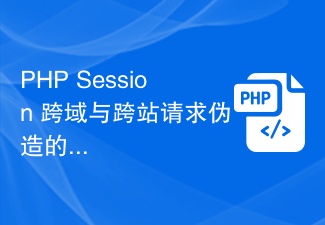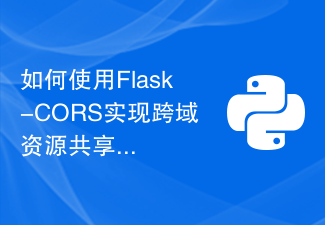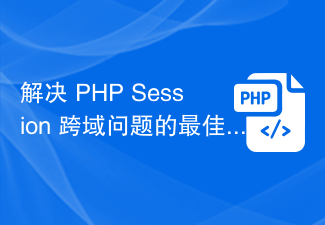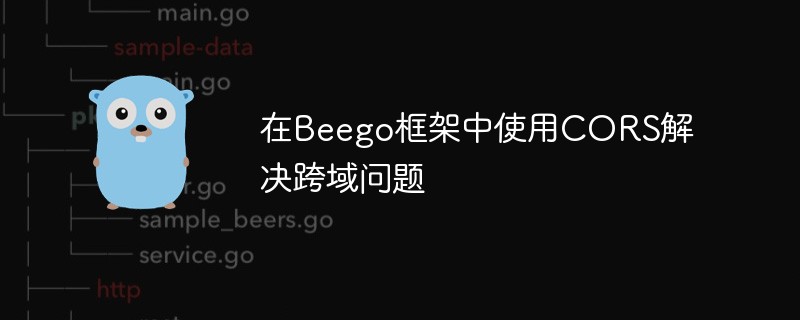 Backend Development
Backend Development PHP Tutorial
PHP Tutorial Adaptability analysis of PHP Session cross-domain and multi-layer system architecture
Adaptability analysis of PHP Session cross-domain and multi-layer system architecture
PHP Session Adaptability Analysis of Cross-domain and Multi-layer System Architecture
With the development of Internet technology, multi-layer system architecture has become more and more important in Web applications. increasingly common. In multi-layer system architecture, cross-domain access is a common requirement. The Session mechanism in PHP is also widely used in functions such as authentication and data sharing in Web applications. This article will delve into the cross-domain adaptability of PHP Session in a multi-layer system architecture and provide specific code examples.
First of all, we need to understand the concept of cross-domain access. Cross-domain access refers to accessing resources on a server on a browser. The domain name of the resource is different from the domain name of the current page. This kind of cross-domain access is usually restricted by browsers. In order to solve this problem, a common approach is to use the CORS (Cross-Origin Resource Sharing) mechanism. The server can allow cross-domain access to specific domain names by setting corresponding response headers.
In a multi-tier system architecture, front-end pages and back-end APIs are usually separated into different domains or subdomains. Front-end pages typically run under one domain or subdomain, while the back-end API runs under another domain or subdomain. In this case, the front-end page needs to access the back-end API across domains, while also maintaining user identity authentication and data sharing.
For PHP Session, it is a mechanism for storing user-related information on the server side. In the case of cross-domain access, if the domains of the front-end page and the back-end API are different, the PHP Session mechanism cannot be implemented by default. This is because PHP Session is implemented based on cookies, and browsers will not automatically send cookies between different domains.
In order to solve this problem, there are several common solutions:
- Cross-domain proxy: The front-end page can use a cross-domain proxy to access the back-end API, and the cross-domain proxy will Send a request containing Session information to the back-end API, and return the response from the back-end API to the front-end page. This method maintains the validity of the Session and enables identity authentication and data sharing. The following is an example, using the GuzzleHttp library to implement cross-domain proxy:
// 前端页面
$response = $client->get('http://api.example.com/data', [
'headers' => [
'Cookie' => $_COOKIE['PHPSESSID'], // 将前端页面的 Session ID 发送给后端 API
],
]);
$data = json_decode($response->getBody(), true);
// 后端 API
session_id($_SERVER['HTTP_COOKIE']); // 使用前端页面发送的 Session ID
session_start();
// 从 PHP Session 中获取数据并返回给前端页面- Cross-domain Shared Session: If the trust relationship between domain names is strong, you can use the shared Session method to achieve Cross-domain access. This approach requires establishing trust between the front-end page and the back-end API, typically by sharing a Session ID passed between different domain names. The following is an example of using Cookie to share Session ID across domains:
// 前端页面
$response = $client->get('http://api.example.com/authorize');
$sessionId = $response->getHeader('Set-Cookie')[0]; // 获取后端 API 发送的 Session ID
setcookie('PHPSESSID', $sessionId, time() + 86400, '/', 'example.com'); // 设置前端页面的 Session ID
// 后端 API
session_start();
// 执行身份验证等操作,并将 Session ID 返回给前端页面Through the above two methods, we can achieve cross-domain adaptation of PHP Session in a multi-layer system architecture. Based on specific business needs and security requirements, you can choose an appropriate method to adapt to cross-domain access.
The above is the detailed content of Adaptability analysis of PHP Session cross-domain and multi-layer system architecture. For more information, please follow other related articles on the PHP Chinese website!
 PHP Session 跨域与跨站请求伪造的对比分析Oct 12, 2023 pm 12:58 PM
PHP Session 跨域与跨站请求伪造的对比分析Oct 12, 2023 pm 12:58 PMPHPSession跨域与跨站请求伪造的对比分析随着互联网的发展,Web应用程序的安全性显得格外重要。在开发Web应用程序时,PHPSession是一种常用的身份验证和会话跟踪机制,而跨域请求和跨站请求伪造(CSRF)则是两种主要的安全威胁。为了保护用户数据和应用程序的安全性,开发人员需要了解Session跨域和CSRF的区别,并采
 Memcached缓存技术对于PHP中的Session处理的优化May 16, 2023 am 08:41 AM
Memcached缓存技术对于PHP中的Session处理的优化May 16, 2023 am 08:41 AMMemcached是一种常用的缓存技术,它可以使Web应用程序的性能得到很大的提升。在PHP中,常用的Session处理方式是将Session文件存放在服务器的硬盘上。但是,这种方式并不是最优的,因为服务器的硬盘会成为性能瓶颈之一。而使用Memcached缓存技术可以对PHP中的Session处理进行优化,提高Web应用程序的性能。PHP中的Session处
 Vue 中如何进行跨域请求?Jun 10, 2023 pm 10:30 PM
Vue 中如何进行跨域请求?Jun 10, 2023 pm 10:30 PMVue是一种流行的JavaScript框架,用于构建现代化的Web应用程序。在使用Vue开发应用程序时,常常需要与不同的API交互,而这些API往往位于不同的服务器上。由于跨域安全策略的限制,当Vue应用程序在一个域名上运行时,它不能直接与另一个域名上的API进行通信。本文将介绍几种在Vue中进行跨域请求的方法。1.使用代理一种常见的跨域解决方案是使用代理
 如何使用Flask-CORS实现跨域资源共享Aug 02, 2023 pm 02:03 PM
如何使用Flask-CORS实现跨域资源共享Aug 02, 2023 pm 02:03 PM如何使用Flask-CORS实现跨域资源共享引言:在网络应用开发中,跨域资源共享(CrossOriginResourceSharing,简称CORS)是一种机制,允许服务器与指定的来源或域名之间共享资源。使用CORS,我们可以灵活地控制不同域之间的数据传输,实现安全、可靠的跨域访问。在本文中,我们将介绍如何使用Flask-CORS扩展库来实现CORS功
 解决 PHP Session 跨域问题的最佳实践Oct 12, 2023 pm 01:40 PM
解决 PHP Session 跨域问题的最佳实践Oct 12, 2023 pm 01:40 PM解决PHPSession跨域问题的最佳实践随着互联网的发展,前后端分离的开发模式越来越普遍。在这种模式下,前端与后端可能部署在不同的域名下,这就导致了跨域问题的出现。而在使用PHP的过程中,跨域问题也涉及到Session的传递与管理。本文将介绍PHP中解决Session跨域问题的最佳实践,并提供具体的代码示例。使用Cookie使用Coo
 如何在HTML中允许跨域使用图像和画布?Aug 30, 2023 pm 04:25 PM
如何在HTML中允许跨域使用图像和画布?Aug 30, 2023 pm 04:25 PM为了允许跨域使用图像和画布,服务器必须在其HTTP响应中包含适当的CORS(跨域资源共享)头。这些头可以设置为允许特定的来源或方法,或者允许任何来源访问资源。HTMLCanvasAnHTML5CanvasisarectangularareaonawebpagethatiscontrolledbyJavaScriptcode.Anythingcanbedrawnonthecanvas,includingimages,shapes,text,andanimations.Thecanvasisagre
 Vue技术开发中遇到的跨域问题及解决方法Oct 08, 2023 pm 09:36 PM
Vue技术开发中遇到的跨域问题及解决方法Oct 08, 2023 pm 09:36 PMVue技术开发中遇到的跨域问题及解决方法摘要:本文将介绍在Vue技术开发过程中,可能遇到的跨域问题以及解决方法。我们将从导致跨域的原因开始,然后介绍几种常见的解决方案,并提供具体代码示例。一、跨域问题的原因在Web开发中,由于浏览器的安全策略,浏览器会限制从一个源(域、协议或端口)请求另一个源的资源。这就是所谓的“同源策略”。当我们在Vue技术开发中,前端与
 在Beego框架中使用CORS解决跨域问题Jun 04, 2023 pm 07:40 PM
在Beego框架中使用CORS解决跨域问题Jun 04, 2023 pm 07:40 PM随着Web应用程序的发展和互联网的全球化,越来越多的应用程序需要进行跨域请求。对于前端开发人员而言,跨域请求是一个常见的问题,它可能导致应用程序无法正常工作。在这种情况下,解决跨域请求问题的最佳方法之一是使用CORS。在本文中,我们将重点介绍如何在Beego框架中使用CORS解决跨域问题。什么是跨域请求?在Web应用程序中,跨域请求是指从一个域名的网页向另一


Hot AI Tools

Undresser.AI Undress
AI-powered app for creating realistic nude photos

AI Clothes Remover
Online AI tool for removing clothes from photos.

Undress AI Tool
Undress images for free

Clothoff.io
AI clothes remover

AI Hentai Generator
Generate AI Hentai for free.

Hot Article

Hot Tools

SublimeText3 Mac version
God-level code editing software (SublimeText3)

SAP NetWeaver Server Adapter for Eclipse
Integrate Eclipse with SAP NetWeaver application server.

Atom editor mac version download
The most popular open source editor

mPDF
mPDF is a PHP library that can generate PDF files from UTF-8 encoded HTML. The original author, Ian Back, wrote mPDF to output PDF files "on the fly" from his website and handle different languages. It is slower than original scripts like HTML2FPDF and produces larger files when using Unicode fonts, but supports CSS styles etc. and has a lot of enhancements. Supports almost all languages, including RTL (Arabic and Hebrew) and CJK (Chinese, Japanese and Korean). Supports nested block-level elements (such as P, DIV),

SecLists
SecLists is the ultimate security tester's companion. It is a collection of various types of lists that are frequently used during security assessments, all in one place. SecLists helps make security testing more efficient and productive by conveniently providing all the lists a security tester might need. List types include usernames, passwords, URLs, fuzzing payloads, sensitive data patterns, web shells, and more. The tester can simply pull this repository onto a new test machine and he will have access to every type of list he needs.





